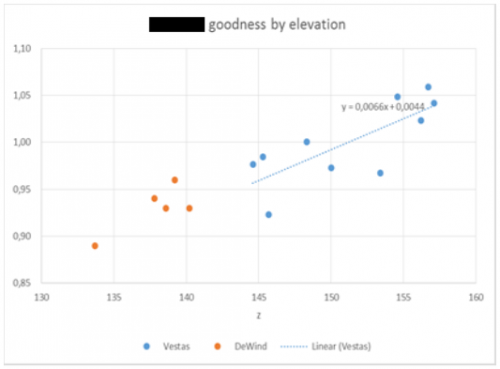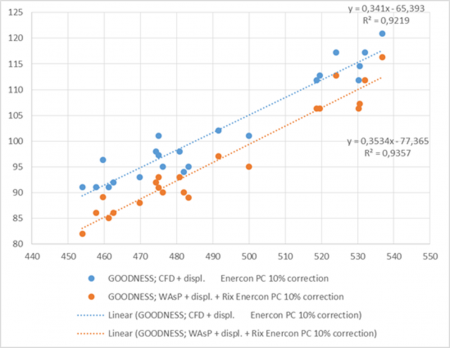Schwächen des WAsP-Orographiemodells (Englisch)
Zur deutschen Hauptseite | Alle deutschsprachigen Seiten
Elevation model pitfalls
Based on many post construction evaluations, some trends are seen when doing a calculation in elevated terrain. The two major issues are:
- In less steep terrain, higher elevated turbines are under predicted by the WAsP model relative to lower elevated turbines. With WAsP-CFD, similar results are seen, although there is some improvement.
- In steep terrain (>30% slopes) higher elevated turbines are over predicted by the WAsP model relative to lower elevated turbines. The RIX correction can partially repair this problem, however, the WAsP-CFD, or other CFD models, would be a better choice than the WAsP model in this scenario.
Image: Ratio measured/calculated for a site in Germany with elevation differences
Above is an example from a German site with turbines in elevation from 133m to 157m. A very clear trend is seen in that the turbines with lower elevation are over predicted relative to the turbines with higher elevation - an almost 7% per 10m elevation difference. Based on more internal calculation examples, the value varies from 3- 7% per 10m. This has high importance when having reference turbines with different elevations relative to the new project to be calculated.
Image: Example as in previous figure, but including WAsP CFD calculation
Above is another example, with a less clear trend, but where WAsP-CFD is tested as an alternative to WAsP. For WAsP, a ratio of 7% per 10m is shown, as in the previous example. This ratio is lowered to 3% per 10m when based on WAsP-CFD.
For complex terrain (large steepness), see the WAsP-CFD validation paper on the EMD help desk website.

